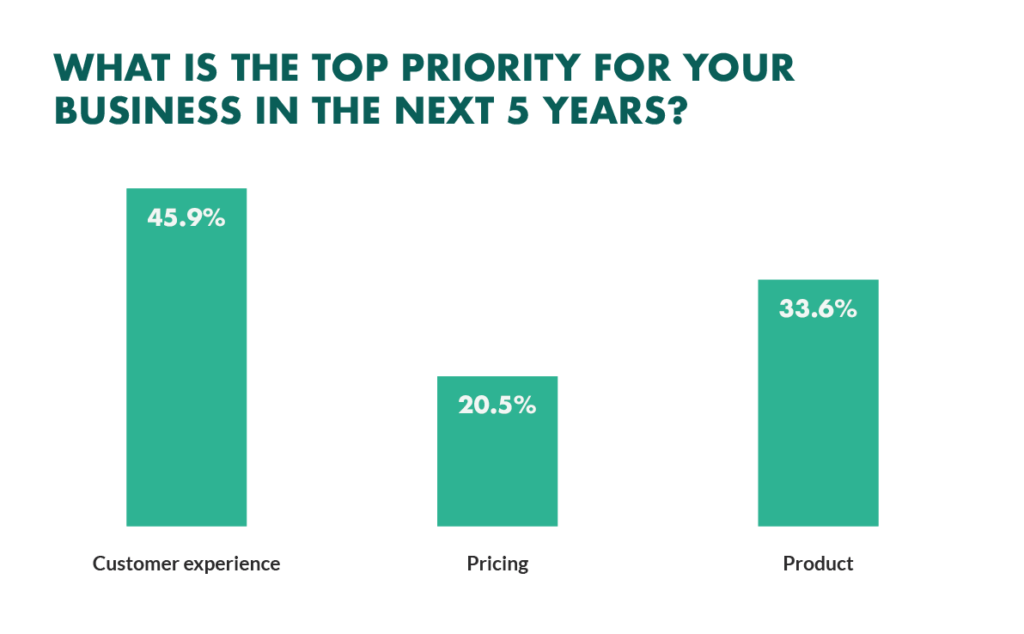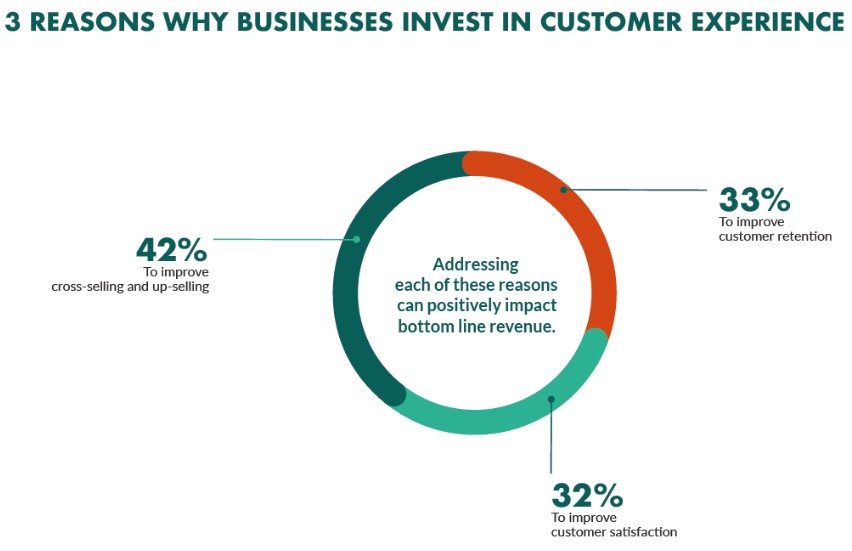It seems like retail trends are evolving faster than ever these days, driven by changing consumer preferences, technology, and global events. In 2023 and beyond, small businesses must remain agile and adapt to new online and in-store customer experience trends to stay competitive. Let’s take a look at six key customer experience trends in retail to keep an eye on, as well as how you can capitalize on them.
1. Businesses Are Prioritizing Retail Customer Experience
There’s no doubt that investing in your customer experience will yield a solid ROI. And businesses are warming up to the idea. In fact, it’s the top priority for the next five years, according to nearly 46% of businesses.
CX is also a top priority for contact centers—ranking more important than cost control among customer service leaders.
If done well, your CX improvements can directly improve your bottom line, considering 86% of shoppers will pay more for your products or services if you offer a good customer experience.
Check out our article on retail trends for more timely insight to keep you ahead of the competition.
2. Employee Retention Helps Improve Retail Customer Experience
Your loyal employees are likely to have intimate subject matter expertise that can make a real positive impact on the customer experience. And organizations are catching on to this idea.
According to Zenefits, more than six in 10 businesses agree that retaining workers is more difficult than hiring them. The most common reasons for employees leaving their jobs are:
- Higher earnings at a different job
- Conflicts with managers or colleagues
- Changes in personal life
- Better benefits package at a different job
- Increased responsibilities or promotion at a different job
Another survey found that customer service employees leave because they’re seeking a change in salary, career path, or job share and enrichment activities.
Regardless of the data you consider, it’s important to offer appropriate onboarding and training so workers feel empowered and ready for their new roles. Check out these other resources to help you set up new hires for success:
- How to Conduct New Employee Orientation in 5 Quick Steps (+ Free Checklist)
- 12 Types of Employee Training to Enhance Workforce Skills
- 17 Employee Training Methods (+ Free Plan Template)
- How to Write a Job Description + Free Template
3. Personalization Is Key
Personalization continues to be a priority for consumers and businesses alike. Yet just over a third of consumers believe businesses excel in their personalization strategies, even though 71% of businesses think they’re doing well. This means there’s lots to capitalize on when it comes to this customer experience trend opportunity.
Personalization pays off. More than half (56%) of consumers say they’re more likely to become a repeat buyer after a personalized shopping experience with a brand. And two-thirds (71%) of consumers say they’ll shop more often with companies that personalize the experience. And they’re willing to share data in order to get those experiences—44% of shoppers, according to one survey.
To take advantage of this trend in our list of 2023 customer experience trends, start with your customer data. Implement a customer relationship management (CRM) system that can create customer profiles and segments which you can use to create campaigns and offers tailored to each segment’s preferences.
Learn more in these resources:
- 9 Best Simple CRM Systems for 2023
- How to Create a Customer Persona in 5 Steps (+ Free Template)
- What Is a CRM Process? 6 Steps to Create Your Own
4. Consumers Demand Sustainability
Your carbon footprint plays an indirect but increasingly important role in CX. Today’s consumers care about what goes into your products and what kind of impact your supply chain and operating practices have on the environment.
According to one survey, nearly a quarter of shoppers don’t want synthetic or otherwise harmful materials in the products they buy, 19% want minimal packaging, and 19% expect brands to take steps to offset their carbon footprint.
These values influence consumer spending behavior—nearly 80% consider a brand and its products’ sustainability when making purchases.
To appeal to this customer experience trend in 2023, be transparent about your business practices. Showcase what materials you use to create your products, give insight into your supply chain, and go behind the scenes to give a firsthand look at what you’re doing to be more environmentally friendly.
Related: 15 Top Ecommerce Trends in 2023
5. Inventory Plays a Role
Omnichannel has been one of the top trends in customer experience for recent years, and inventory management is one key component of that. Shoppers expect to see what’s in stock and what’s unavailable whether they’re in your store or browsing online. It’s important to sync inventory data to provide the best customer experience.
This becomes increasingly difficult as you open additional store locations. According to one survey, “store inventory accuracy” is the top challenge when it comes to managing the digital aspects of the business.
To provide accurate inventory transparency, it’s important to sync your data. Your inventory management software, website, and store point-of-sale (POS) system should all be able to talk to one another to provide up-to-the-minute inventory information regardless of the channel. These resources can help you navigate:
- 6 Best POS Inventory Systems in 2023
- How to Organize Inventory for Small Businesses in 9 Steps
- Retail Inventory Management: Definition & 5 Best Practices
6. AI Helps Businesses Improve CX
Artificial intelligence (AI) is transforming the retail industry, and retailers are increasingly adopting AI in their businesses. Retailers are using AI for everything from marketing to ecommerce. As many as 85% of retailers plan to use it for supply chain planning, helping them improve service levels by 65%.
Many businesses see the value in AI when it comes to customer data management, with 90% believing it can help “update, manage, and enrich customer databases.” And 73% of consumers prefer local retailers to automate at least one task in their purchase journey instead of using staff, while 44% want an automated tool to get more product information and availability.
Take advantage of AI by using automated and intelligent features available in the tools and platforms you already use. This can help you embrace the technology with an easier learning curve.
Related: 10 POS Trends & Technologies Shaping the Future of Retail
Frequently Asked Questions (FAQs)
Click through the questions below to get answers to some of your most frequently asked customer experience questions.
Customer experience is important in retail because it directly impacts customer satisfaction, loyalty and retention, and profitability. A positive customer experience can lead to repeat business, word-of-mouth recommendations, and increased revenue.
To create a good customer experience in retail, focus on personalized interactions, efficient service, transparent communication, product quality, and training and empowering employees.
Customer experience (CX) refers to the overall interaction a customer has with a brand or business throughout their journey. Examples include personalized recommendations, easy-to-navigate websites, responsive customer support, and hassle-free returns.
Retail experience examples include personalized product recommendations, customer loyalty programs, and immersive shopping experiences.
Bottom Line
Whether you’re just starting a new retail business or looking to improve an existing one, keeping an eye on the biggest retail customer experience trends in 2023 will help you stay ahead of the curve. Prioritizing customer experience, retaining employees, personalizing interactions, embracing sustainability, optimizing inventory management, and leveraging AI are key strategies to improve your CX.

